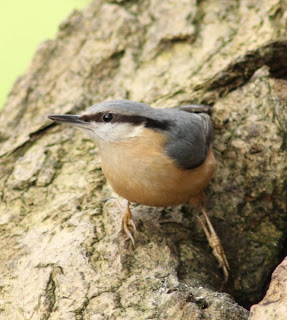I'm relatively new to birding and so there are many UK species I haven't yet seen. There are others I have seen but not managed to get pictures of, or have managed to get a fleeting shot of, but want to improve on. So it's good to be on a couple of birding, and bird photography oriented forums from which I can glean information about where those species may be found locally.
Pennington Flash is a large expanse of former coal workings which have long since collapsed and flooded. Since nature reclaimed the site, and it became overgrown it has become a haven for many species, including some very rare migrants and erratics. But it was not particularly these I was after - rumours of my bogey-bird, the Kingfisher, abound at this site, sightings from the past week and even as recently as yesterday prompted me to set off on Easter Sunday in search of this striking and enigmatic bird.
On arrival I managed to pick up a site map, and despite the heavy drizzle, set off in search of Horrocks Hide, the nearest hide to the carpark. Through the murk, I was able to see Great Crested Grebe, Black Headed Gull, Mute Swan, Lapwing and a small group of 8-10 Snipe around the area known as 'The Spit'. But alas, Horrocks Hide doesn't overlook the kind of terrain a Kingfisher was likely to frequent, so onwards to the more promising Tom Edmondson Hide. At the side of Kidney Pond I spotted a pair of Mute Swans busily nest building and could hear Chiffchaff singing in the hedgerows, but in a bid to try and keep dry I headed straight inside Edmondson Hide, only to be informed by a couple of other birdwatcher/photographers that I was 'a couple of minutes too late' a Grey Heron had just taken a medium sized Pike right in front of the hide! The Heron was still around, and looking out for dessert, so I hung around for a while. I was able to watch a pair of Canada Geese defending their territory from a troublesome Carrion Crow, a Wren foraging fairly close to the hide and a pair of Teal meandering through the reed-beds, but alas, no second performance from the Heron.
Between Edmondsons & Ramsdale Hide I was able to catch sight of a
male Blackcap, but due to the undergrowth, was unable to get a shot of
him. However it was another species ticked off the 'sighting list' but which remains firmly on the
'still to get a pic of' list. Once at Ramsdale Hide, I got distant views of
Redshank, not ideal as it was still drizzling and the light was from the wrong direction, but a tick
for the day nonetheless.
 |
| Redshank from Ramsdales Hide |
|
Also on view from Ramsdales were several pairs of Teal, ever excitable Lapwing and a couple of pairs of Gadwall.
 |
| Pair of Gadwall from Ramsdales Hide |
Moving on from Ramsdales and a good walk round to Teal Hide along well made paths, allegedly liable to flooding, there was a good variety of more common birds singing in the trees, Blue Tit, Great Tit, Wren and the ubiquitous Robin.
 |
| Co-operative Robin |
It was along this path that I also got a sighting AND a picture of... A Kingfisher!
 |
| My First Kingfisher! |
OK OK, so I know that's cheating, but it was a start.. The question remained; would I get a better opportunity, and a real bird, during my travels??
From Lapwing Hide, I could see... nothing, not a sausage, not a Lapwing, not even a Canada Goose! So onwards once more, this time heading for Bunting Hide, and the feeding station.
Once inside Bunting Hide, I was stunned. I have seen perhaps 6 Bullfinch in all my life, 2 at Leighton Moss which were spooked by a Sparrowhawk, a pair in my garden early in 2011 and a couple at a campsite in North Wales, also last year. But here, from just one hide, I could see perhaps a dozen! 12+ Bullfinch, all around me!
 |
| A glut of Bullfinch! |
It was difficult to watch them, as they flitted around, I was spoiled for choice as to where to point the camera next! I always aim to try and get more 'natural' looking shots, but when 2 pairs landed on one of the seed-tables at once I just had to break my own rules!
Also hanging aorund the feeding station were a couple of Greenfinch, several Reed Bunting
Blackbird, Magpie, Blue Tit, Great Tit and a pair of Willow Tit.
 |
| Reed Bunting from the aptly named Bunting Hide |
 |
| Magpie from Bunting Hide |
Bird of the Day - without doubt the Bullfinch! After the view from the feeding station I had to admit defeat as my fingers were going so numb I could hardly hold the camera, let alone press the shutter! Considering the weather, today was a very worthwhile explorative trip and I will definately be returning once we have more 'reliable' weather and favourable light.






















































